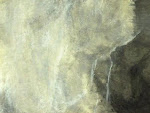水墨画の描き方を順次公開いたします。
The English text was helped by Eve Loh Kazuhara-san. Thank you Eve.
英文は〔Eve Loh Kazuhara〕さんの助けを得ました。有難うございます。
--------------------------------------------------
How to draw pictures with thought of ”The Six Principles of Chinese Painting (画の六法)”.
Xie He (謝赫 |しゃかく- Years of birth and death unknown), a painter and writer in the Southern Qi-dynasty of China (479-502 CE), published "The Record of the Classification of Old Painters" (古畫品錄 | こがひんろく) . In this book he explained that six elements defined Chinese Painting. My interpretation of “The Six Principles of Chinese Painting” are as follows.
- Spirit Resonance (気韻生動 | きいんせいどう)The energy transmitted to the work from the artist who acquired the spiritual strength from the great nature.
- Bone Method (骨法用筆 | こっぽうようひつ) the way of using the brush.
- Correspondence to the Object (応物象形 | おうぶつしょうけい) the depiction of form.
- Suitability to Type (随類賦彩 | ずいるいふさい) the application of color, including layers, value and tone.
- Division and Planning (経営位置 | けいえいいち) the composition, space and depth, placement of the painting)
- Transmission by Copying (伝模移写 | でんもいしゃ) Copy the spirit of the master's works.
There was no elaboration on “The Six Principles of Chinese Painting” in “The Record of the Classification of Old Painters”. However Zhang Yanyuan (張彦遠 | ちょう, げんえん) published “Famous Paintings through History (歴代名画記 | れきだいめいがき) ” and his interpretation of the “Six Principles” is firmly established as follows.
“I (Yanyuan) will argue that the painters of the old days would do well if there were firm skeletons in the shapes of things. It is not that the shapes are similar. It is difficult to teach that to the general public.
The paintings in the present are similar in shape, but few possess vitality. If you draw a picture with Spirit Resonance, the shape is close to the truth. Pictures of ancient times, such as Gu Kaizhi (顧愷之 | こがいし) and Lu Tanwei (陸探微 | りくたんび), the handwriting is simple but draws the essence of things. Moreover, it is elegant. The pictures of the middle ages are finely-detailed and beautiful. See Zhan Ziqian(展子虔 | てんしけん) and Zheng Fashi (鄭法士 | ていほうし) . Modern paintings shine brightly, seeking completeness. Present-day painters are confused and their paintings have no emotion.”
Based on this theory of painting, Xie Hu ranked paintings and wrote "article theory". He initially divided the ranking into upper, middle and lower categories. After that, he renamed these categories "God-like (神品)", "excellent works (妙品)", "skillful works (能品)" and divided these into six.
After that, Zhu Jingxuan (朱景玄) added in his book "Tao dinersity painters" (唐朝名画録) an "exceptionally excellent (逸品) " that did not apply to "The Six Principles of Chinese Painting". "The Six Principles of Chinese Painting 画の六法" has continued as a basic concept of "Oriental paintings" (東洋画) for more than 1500 years. Several interpretations of "The Six Principles of Chinese Painting" vary from time to time, but was useful for assessing the skill and interpretation of paintings.
☆Sample works:
regarded(伝) Gu Kaizhi(顧愷之| こ,がいし)《admonitions of the Instructress to the Court Ladies女史箴図》
 |
| 説明を追加 |
Following this theory, I will explain the painting production technique below.
「中国水墨画の六法」を意識した制作の実際
〔謝赫〕(しゃかく | 生没年不詳。〔南斉〕(479-502)頃活躍) 著の『古画品録』(こがひんろく) に画(絵)を描くための指針である「六法」が以下のようにあります。解説は様々ありますが、筆者の解説を記します。
- 「気韻生動」(きいんせいどう | 神気が満ち、生じて動く生気)
- 「骨法用筆」(こっぽうようひつ | 骨格のある筆の使い方)
- 「応物象形」(おうぶつしょうけい | 物の形に応じて形を作る)
- 「随類賦彩」(ずいるいふさい | 物の種類に応じて彩色を施す)
- 「経営位置」(けいえいいち | 構図、配置)
- 「伝模移写」(でんもいしゃ | 摸本で勉強する) です。
『古画品録』には説明がありません。〔張彦遠〕(ちょう, げんえん) の『歴代名画記』(れきだいめいがき) の解釈(かいしゃく)が一般的です。それは次のような内容です。
「彦遠が試みに論じる。古い画(絵)はその形似(けいじ)をよく移して、しかも、その骨気(こっき | 骨のある筆法)を尚(とうと)ぶ。つまり形似の外のことを以(も)ってその画を求めるもので、これは俗人(ぞくじん | 一般人)の與(ため)に道(いう)べきことは難(むつか)しい。今の画は縦(たと)え、形似を得(え)て、而(しかれども)気韻は生じない。気韻をもってその画を求めるならば、則(すなわ)ち、形似はその間にある。
上古(じょうこ | 古代)の画は、筆跡は簡(かん | かんりゃくのこと)にして意(い | 気持ち)は足り、しかも雅正(がせい | みやびで堂々としている)なり。〔顧愷之〕(こがいし) 、〔陸探微〕(りくたんび) の流れ是(これ)なり。
中古の画は細密精緻(さいみつせいち)にして、(美)麗に臻(至)る。〔展子虔〕(てんしけん) 、〔鄭法士〕(ていほうし) の流れ是(これ)なり。
近代の画は煥爛(かんらん | あざやかにかがやき)にして完備を求める。
今人の画は錯乱にして旨(おもむき)がない。衆工(一般の画工)の迹(あと)が是である」 です。
参考作品:伝〔顧愷之〕《Admonitions of the Instructress to the Court Ladies》
この六法に基づいて〔謝赫〕は一品から六品まで序列化し「品題論」を行ないました。当初は上中下の品別にし、のち、「神品」「妙品」「能品」に分けました。その後、〔朱景玄〕は『唐朝名画録』で、三品にあてはまらない(逸する)【逸品】を加えました 。様々な解釈がありますが、「画の六法」は【東洋画論】の基礎として1500年以上、絵画の制作技法や鑑賞に役立ちました。分かりやすいので順序を変えて、以下に説明いたします。
次に続く





0 件のコメント:
コメントを投稿